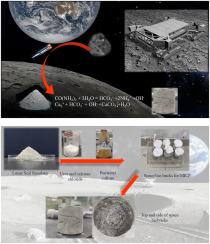Innovative applications of microbial induced carbonate precipitation (MICP) for extraterrestrial construction
IF 3.4
2区 物理与天体物理
Q1 ENGINEERING, AEROSPACE
引用次数: 0
Abstract
The idea of in-situ resource utilization (ISRU) for building extraterrestrial bases on the moon and Mars has become increasingly popular. This review outlines the latest developments in fabrication of space construction materials using microbial induced carbonate precipitation (MICP) technology. This innovative approach uses the urease of Sporosarcina pasteurii to promote the precipitation of calcium carbonate from external carbon and nitrogen sources. By using lunar and Martian stardust (afterward called soils in this review) as raw materials, this method presents a sustainable alternative to the difficult and costly process of transporting building materials from Earth to space. The Moon is rich in ilmenite, and TiO2 is sometimes envisioned to produce H2, O2, and H2O, which could serve as a new water source for MICP on the Moon (Technology Readiness Level≤3). This paper focuses on three key aspects of space construction-related materials and technologies. First, it elaborates the continuous advancement in the understanding of lunar and Martian soils, covering the detailed composition and sourcing methods of lunar soil simulants and Martian soil simulants. Second, it explores the complex operational mechanism and considerable application potential of microbially induced calcite precipitation (MICP) technology. Third, it discusses the improvement to the physical properties of space bio-bricks, which endows them with promising application prospects as space construction materials. Additionally, the paper identifies current challenges in this field, such as technical bottlenecks, and outlines the essential research progress required in the future. It expresses optimism that MICP technology will play a pivotal role in revolutionizing space construction by developing robust and eco-friendly materials.

微生物诱导碳酸盐沉淀(MICP)在地外建筑中的创新应用
在月球和火星上建立地外基地的就地资源利用(ISRU)理念日益流行。本文综述了利用微生物诱导碳酸盐沉淀(MICP)技术制备空间建筑材料的最新进展。这种创新的方法使用巴氏孢杆菌的脲酶来促进碳酸钙从外部碳和氮源的沉淀。通过使用月球和火星的星尘(在本评论中称为土壤)作为原材料,这种方法为将建筑材料从地球运输到太空的困难和昂贵的过程提供了一种可持续的替代方案。月球上钛铁矿丰富,二氧化钛有时被设想产生H2、O2和H2O,可以作为月球上MICP的新水源(Technology Readiness Level≤3)。本文重点介绍了空间建筑相关材料和技术的三个关键方面。首先,阐述了对月球和火星土壤认识的不断进步,包括月球土壤模拟物和火星土壤模拟物的详细组成和来源方法。其次,探讨了微生物诱导方解石沉淀(MICP)技术复杂的运行机理和可观的应用潜力。第三,讨论了空间生物砖物理性能的改进,使其作为空间建筑材料具有广阔的应用前景。此外,本文还指出了该领域当前面临的挑战,如技术瓶颈,并概述了未来需要的基本研究进展。它乐观地表示,通过开发坚固和环保的材料,MICP技术将在太空建设革命中发挥关键作用。
本文章由计算机程序翻译,如有差异,请以英文原文为准。
求助全文
约1分钟内获得全文
求助全文
来源期刊

Acta Astronautica
工程技术-工程:宇航
CiteScore
7.20
自引率
22.90%
发文量
599
审稿时长
53 days
期刊介绍:
Acta Astronautica is sponsored by the International Academy of Astronautics. Content is based on original contributions in all fields of basic, engineering, life and social space sciences and of space technology related to:
The peaceful scientific exploration of space,
Its exploitation for human welfare and progress,
Conception, design, development and operation of space-borne and Earth-based systems,
In addition to regular issues, the journal publishes selected proceedings of the annual International Astronautical Congress (IAC), transactions of the IAA and special issues on topics of current interest, such as microgravity, space station technology, geostationary orbits, and space economics. Other subject areas include satellite technology, space transportation and communications, space energy, power and propulsion, astrodynamics, extraterrestrial intelligence and Earth observations.
 求助内容:
求助内容: 应助结果提醒方式:
应助结果提醒方式:


